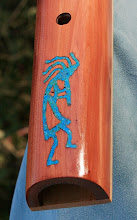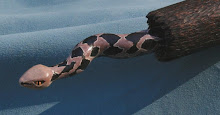
The analogy of a Cracker Jack box comes to mind, where you get a cardboard box that is full of not only sweet things but a surprise that delighted me as a little kid. OK, point taken, I spent little of my life actually 'little'...but this particular 'kid' (as I call all my flutes) has thoroughly done that, delighted me. In case you didn't see yesterday's post, here it is in all it's fibrous glory...
(click on pics to enlarge)
 ...the now-Ugly-Boy when it was just a throw-away stick...
...the now-Ugly-Boy when it was just a throw-away stick...
[Lest I forget, it's a high B tuned to Verdi frequencies (A432) and is ~24 inches long] Once glued, then tapped for sound and voice, the careful sanding began. I wanted to remove the oxidized stuff and yet I didn't want to remove 'character' that I was seeing, and there was a lot of it. With a magical break in the weather, I quickly photographed what I now call "The Howler"...as I was photographing some of the wonderful intricate detailed grain patterns, this one jumped out at me as a ululating wolf...see if you can see it, too...
 For those that had any trouble seeing it, I did a little key fer ya...
For those that had any trouble seeing it, I did a little key fer ya...

 This flute is just loaded with interesting patterns...
This flute is just loaded with interesting patterns...


 As above and below, there were voids that I had to fill in...while I could have used something like Turquoise or malachite, I decided to stay 'natural' and used cedar dust. I simply would add a watery superglue and press the dust in, then 'water' the top with the watery glue. Makes a rock-hard and pretty inlay, if I do say so myself.
As above and below, there were voids that I had to fill in...while I could have used something like Turquoise or malachite, I decided to stay 'natural' and used cedar dust. I simply would add a watery superglue and press the dust in, then 'water' the top with the watery glue. Makes a rock-hard and pretty inlay, if I do say so myself.
 I mentioned in yesterday's post about avoiding sticks with pronounced splits, as such cracks are rarely singular in nature or on the same plane. Case in point for this flute as a couple of large pieces flew off when cut with the saw and also with the Kutzall bit I used to rout out the chambers. In this case it was easier to fill it in as opposed to go look for the wood or try to custom fit some odd piece in the void...all part of the 'on the fly' decisions I have to make.
I mentioned in yesterday's post about avoiding sticks with pronounced splits, as such cracks are rarely singular in nature or on the same plane. Case in point for this flute as a couple of large pieces flew off when cut with the saw and also with the Kutzall bit I used to rout out the chambers. In this case it was easier to fill it in as opposed to go look for the wood or try to custom fit some odd piece in the void...all part of the 'on the fly' decisions I have to make.
The mouthpiece ended up being quite wide where I had decided to cut the branch...so instead of boring the hole and then shaping down to the opening like I would normally do, I left it as-is and had this flash to simply use a sander and make it concave. Never done it before, never seen it, but it is really easy to play and so I've given the design an appropriate monikor: "The Kisser". That's how you play it, just 'kiss' it and blow...
 Here are a few views of the almost-finished flute, the High B "Howler"...
Here are a few views of the almost-finished flute, the High B "Howler"...



 Not too bad a transformation of kindling, eh? Carpe diem, y'all!
Not too bad a transformation of kindling, eh? Carpe diem, y'all!
(click on pics to enlarge)
 ...the now-Ugly-Boy when it was just a throw-away stick...
...the now-Ugly-Boy when it was just a throw-away stick... [Lest I forget, it's a high B tuned to Verdi frequencies (A432) and is ~24 inches long] Once glued, then tapped for sound and voice, the careful sanding began. I wanted to remove the oxidized stuff and yet I didn't want to remove 'character' that I was seeing, and there was a lot of it. With a magical break in the weather, I quickly photographed what I now call "The Howler"...as I was photographing some of the wonderful intricate detailed grain patterns, this one jumped out at me as a ululating wolf...see if you can see it, too...
 For those that had any trouble seeing it, I did a little key fer ya...
For those that had any trouble seeing it, I did a little key fer ya...
 This flute is just loaded with interesting patterns...
This flute is just loaded with interesting patterns...

 As above and below, there were voids that I had to fill in...while I could have used something like Turquoise or malachite, I decided to stay 'natural' and used cedar dust. I simply would add a watery superglue and press the dust in, then 'water' the top with the watery glue. Makes a rock-hard and pretty inlay, if I do say so myself.
As above and below, there were voids that I had to fill in...while I could have used something like Turquoise or malachite, I decided to stay 'natural' and used cedar dust. I simply would add a watery superglue and press the dust in, then 'water' the top with the watery glue. Makes a rock-hard and pretty inlay, if I do say so myself. I mentioned in yesterday's post about avoiding sticks with pronounced splits, as such cracks are rarely singular in nature or on the same plane. Case in point for this flute as a couple of large pieces flew off when cut with the saw and also with the Kutzall bit I used to rout out the chambers. In this case it was easier to fill it in as opposed to go look for the wood or try to custom fit some odd piece in the void...all part of the 'on the fly' decisions I have to make.
I mentioned in yesterday's post about avoiding sticks with pronounced splits, as such cracks are rarely singular in nature or on the same plane. Case in point for this flute as a couple of large pieces flew off when cut with the saw and also with the Kutzall bit I used to rout out the chambers. In this case it was easier to fill it in as opposed to go look for the wood or try to custom fit some odd piece in the void...all part of the 'on the fly' decisions I have to make. The mouthpiece ended up being quite wide where I had decided to cut the branch...so instead of boring the hole and then shaping down to the opening like I would normally do, I left it as-is and had this flash to simply use a sander and make it concave. Never done it before, never seen it, but it is really easy to play and so I've given the design an appropriate monikor: "The Kisser". That's how you play it, just 'kiss' it and blow...
 Here are a few views of the almost-finished flute, the High B "Howler"...
Here are a few views of the almost-finished flute, the High B "Howler"...


 Not too bad a transformation of kindling, eh? Carpe diem, y'all!
Not too bad a transformation of kindling, eh? Carpe diem, y'all!



















